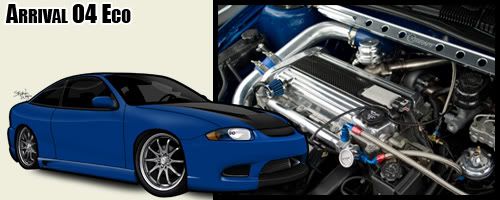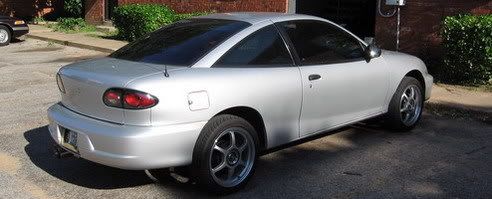I've never has oil drip out of the breather filters on any vehicle I've even owned - which includes many cars some naturally aspirated and some boosted(boosted by me - not factory). - and I always use breather filters. If yours leaks(assuming that this is actually the real cause of your oil leak - check the valve cover gasket etc), might I suggest that yours isn't sealed very good at all.
Misnblu wrote:Here is some information better explaining the process of air/ oil seperator, the PCV system, and why you need to have crankcase ventilation through vacuum from the intake system.
This will further explain why using a breather filter is no good for our cars.
No, you don't NEED to have crankcase ventilation via Vacuum from your intake. And using breather filters is perfectly fine for our cars, and I might argue - an even better option than using intake vacuum.
Quote:
Air circulated in the interior of a gasoline engine becomes contaminated therein with gasoline and oil vapors trapped in the crankcase. This contaminated air is then fed, by means of intake manifold vacuum, to the cylinder for combustion.
The only problem being that blow-by is just exhaust aka already combusted gasoline. It isn't going to burn again. The main byproduct of this combustion is water - which really isn't going to burn either, nor will it help the combustion process if max power or fuel economy is a concern.
Quote:
By passing the contaminated air through a filtering means prior to combustion, the oil vapors are removed, providing longer spark plug life and improved engine performance and reduced oil and grease deposits in the intake manifold. A drain in the filter returns the oil collected to the crankcase for reuse.
And yet that isn't even a problem if you just use a crankcase breather filter.
Quote:
BACKGROUND OF THE INVENTION
In a typical gasoline-powered automobile engine, a carburetor mixes controlled quantities of filtered air and fuel and feeds the resultant mixture to an intake manifold, from which it is distributed to the cylinder for combustion. The by-products of this combustion are then vented, through emission control devices, to the atmosphere. Engine designers and manufactures have long been aware that as the fuel-air mixture is compressed by the piston in a particular cylinder, a small quantity of the mixture slips by the piston sealing rings, escaping into the crankcase, or interior portion, of the engine block.
Until the early 1960's these blow-by vapors and other contaminents trapped in the crankcase, such as oil vapors emitted by heated engine-lubricating oil, were simply vented into the atmosphere through small ports on the engine block. Since that time, however, engines have been equipped with positive crankcase ventilation (PCV). In this system, a stream of fresh air is directed into the engine interior wherein it circulates, picking up the vapors therein. The contaminated flowing air then leaves the engine through a PCV valve and is conducted by conduit means to the intake manifold, wherein it mixes with the fuel-air mixture provided by the carburetor and is distributed to the cylinders for combustion. Non-combustible components are released, through emission control devices, to the atmosphere. Vacuum in the intake manifold maintains the flow of air through the system.
That isn't even how it works. "Non-combustible components are released" - no they aren't. Those "non-combustible elements" are fed into the combustion chamber where... they don't combust. Big surprise there.
The PCV doesn't "direct fresh air into the engine" - it uses intake manifold vacuum(only present when not at heavy throttle) to such blow-by out of the crankcase. Note that the PCV valve shuts(and thus does nothing) when you open the throttle all the way. That is where the factory intake hose comes into play. It uses intake vacuum to basically do the same thing the PCV valve does the rest of the time. But alternatively, you can just put a filter on there, and physics takes care of its own. Blow-by won't build up to much pressure, since it has a simple escape. High pressure seeks low pressure. Using the engine's "vacuum"(technically it isn't really vacuum as much as it is lower pressure than atmospheric) has the exact same effect except that the engine's "vacuum" is of lower pressure. Doesn't really make a big difference. The other differences are that you suck in exhaust which -
1. Dirties the intake system
2. Doesn't produce power, takes the space of regular air that could have been sucked in.
3. Heats the incoming air.
4. Will be metered by the MAP as if it where oxygenated air - which will in turn cause the ECU to unnecessarily add gas, enriching the mixture somewhat.
So in summary, it doesn't help power or economy.
Quote:
SUMMARY OF THE INVENTION
It has been discovered that oil and other contaminants(spelling corrected) mixing with the circulating air in the crankcase and, thereafter, reaching the intake manifold and combustion cylinders, has a number of undesirable and deleterious effects on engine performance, including fouling of spark plugs through accumulation thereon of non-combustible residues, increased exhaust emissions due to the presence of unburned vapors, and decreased gas mileage as a result of incomplete combustion and the necessity of enriching the fuel-air mixture to off-set the loss of power therefrom. It has, further, been discovered that by employing a separator in the path of the contaminated air flow downstream of its exiting the engine block and upstream of the intake manifold, these problems of engine operation are reduced significantly. A filter having an inlet port and an outlet port is connected by hoses to the output of the PCV valve and the intake manifold, respectively. A filtering material of wool or felt is employed, although any material which will pass the air and separate therefrom liquid and solid contaminants(spelling corrected) is sufficient. In a preferred embodiment of the invention, oil is collected in the bottom of the filter and drained, during periods of non-operation of the engine, through an air-check valve into the crankcase, where it remixes with the lubricating oil from which it came. Thus, yet another advantage of the invention is a reduction in oil consumption.
The article is correct there - but those things aren't even concerns when you just use a simple crankcase breather filter.
The real reason to use the factory method - with or without a catch-can - is emissions. Blow-by is exhaust, and the EPA isn't too fond of your exhaust bypassing emissions control devices - aka your catalytic converter. This matters to -
1. People in emissions control states(like CA)
2. Companies like GM - who report to that same EPA. Now you know why they do it like that.
3. People who are overly environmentally conscious enough to think that your blow-by is gonna kill all the cute squirrels.
Basically this is the same reason that most of us have and EGR valve on our engines - it sure isn't to make more power. The PCV valve is also unneccessary for anything except emissions - but remember removing that requires you to block off the PCV hole in the intake manifold and block(or add another breather filter to) where it connects to the other end.
Ronin J wrote:and...no ones flamed this yet??? last time i saw a post about these filters (and posted in it) a couple people turned it into a flame war...
Yep - It did become a flame war and it got locked - but despite that, I
think I managed to get my view on the matter across pretty well without need to flame.
Taetsch Z24 wrote:I DONíT KNOW what is with people and not wanting the car to have crankcase vacuum...... read up on it, it helps keep the oil clean and can help the motor make power.
Chris
It's not that "not wanting the car to have crankcase vacuum" as much as not wanting to suck in blow-by. If you read the rest of my post, you now know why that is. Technically if you really, really want crankcase vacuum, you can always accomplish that via an external vacuum pump(which isn't bad for boosted cars to have anyways - many factory boosted cars do).
Now crankcase vacuum isn't gonna make much difference in your oil being clean - unless you had really large vacuum lines sucking directly from and facing the bottoms of the pistons. You'd need to remove it
before blow-by hits the oil if you want to make any real difference. You're never gonna clean that oil with vacuum, but removing the blow-by helps prevent it from getting worse. But then again, letting it out via breather filter will still accomplish this about as well. Without removing it as I just described(vacuum hose under pistons), you're never gonna completely remove the blow-by(you constantly have more blowing by the piston rings), you can only reduce the pressure of it - the pressure of it would be a little less with vacuum than standard venting - but that's really the only difference.
"and can help the motor make power." - I really would like to know how sucking in exhaust helps make power. Enlighten me. If so, I think we've been feeding our engines fresh air all these years like suckers. No I don't mean any offense to you, but that concept doesn't make any sense at all.
I've never heard of this "part throttle" before. Does it just bolt on?












